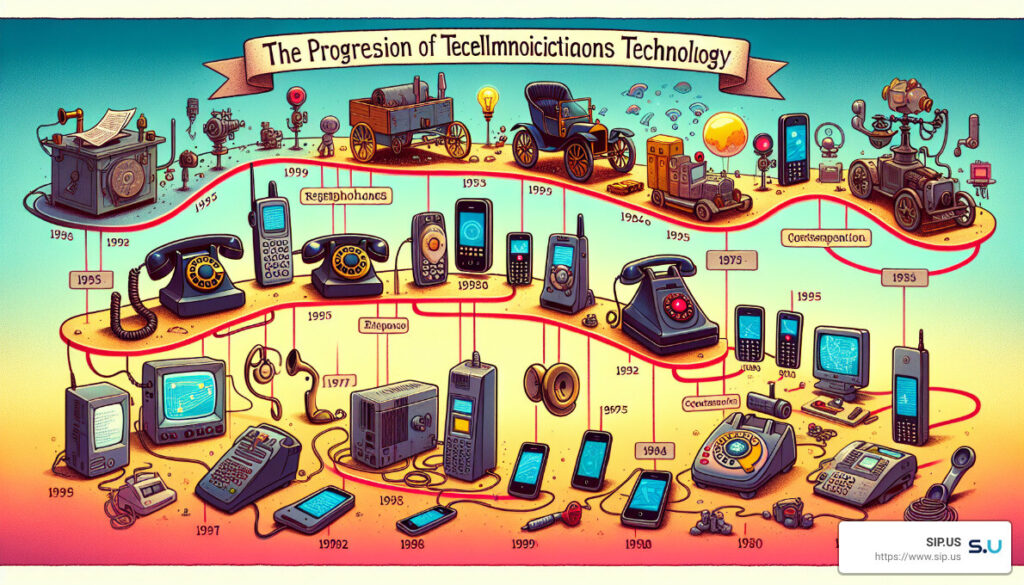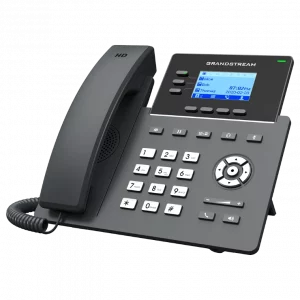
SIP Trunks 101: Understanding Future Trends
Quick Insight: The Future of SIP Trunks
- Market Growth: The SIP trunking market is on a rise, projected to reach US$30.22 billion by 2027.
- Adapting to New Norms: Tailoring to hybrid and remote work environments.
- Enhanced Capabilities: Bolstering communications with mobile SIP services.
- Security Measures: Prioritizing advancements in cybersecurity for safer communications.
Telecommunications have undergone an incredible transformation, moving from traditional landlines to the incredibly adaptable and scalable world of Session Initiation Protocol (SIP) trunks. Today, as businesses and individuals alike seek more reliable, flexible, and cost-effective communication solutions, SIP trunks have emerged as a cornerstone technology in modern telecommunications strategy.
In its essence, SIP trunking represents the evolution of communication, allowing businesses to move away from traditional, physical phone lines to digital, internet-based calling. This shift is not just about keeping up with technology trends; it’s about offering vast improvements in scalability, cost savings, and especially, the capability to support the increasingly prevalent remote and hybrid workforce.
SIP’s rise in prominence isn’t surprising. It reflects a broader shift toward more agile, digital-first business operations. For small to medium-sized businesses looking to modernize their communications, reduce costs, and improve flexibility, understanding the significance and potential of SIP trunking is crucial.
As we look toward the future, SIP trunking is set to play a pivotal role in shaping how businesses communicate, adapt to changes, and maintain connectivity, no matter where their teams are located.

Explore more about how SIP trunking is revolutionizing business communications, enhancing remote work capabilities, and staying at the forefront of telecommunication innovation.
The Rise of SIP Trunking
The future of SIP trunks is unfolding right before our eyes, marked by significant market growth, the rise of cloud-based solutions, and global adoption across industries. Let’s dive into these transformative trends.
Market Growth
The SIP trunking market is experiencing a surge, projected to reach a staggering $43.74 billion by 2031 from $11.96 billion in 2021. This growth isn’t just numbers; it’s a testament to how businesses are recognizing the undeniable benefits of SIP trunking—cost efficiency, scalability, and flexibility. The demand for reliable communication solutions that can scale with business needs is driving this market expansion.
Cloud-based Solutions
Cloud-based SIP trunking is a game-changer. It offers businesses of all sizes the agility to adapt to changing market conditions without the hefty investment in physical infrastructure. This model supports the dynamic nature of today’s business environment, where the ability to quickly adjust and deploy communication resources can be the difference between thriving and merely surviving. The cloud is not just a trend; it’s the future, providing a platform for innovation and growth in telecommunications.
Global Adoption
SIP trunking is not limited by geographical boundaries. Its global adoption is facilitated by the universal nature of the internet, allowing businesses to maintain high-quality communication across the globe. This worldwide embrace is particularly beneficial for companies with a dispersed workforce or those looking to expand into new markets. The ability to connect seamlessly, regardless of location, is a powerful tool in the global business arsenal.
As we look towards the future, the rise of SIP trunking is undeniable. Its impact on market growth, coupled with the advantages of cloud-based solutions and global adoption, sets the stage for a new era in business communications. SIP trunking is not just about saving costs or improving efficiency; it’s about empowering businesses to navigate the complexities of the modern world with confidence and agility.
Stay tuned as we delve deeper into the benefits of SIP trunking, including cost savings, scalability, flexibility, and enhanced communication, in the next section.
Explore the benefits of SIP trunking and how it can transform your business communications.
Learn more about the growth of SIP telephony and the future of telecommunications.
Understand the global trends and future predictions for SIP trunking and VoIP services.
Key Benefits of SIP Trunking
In business communication, SIP trunking is not just a buzzword; it’s a game-changer. Let’s dive into the key benefits that make SIP trunking a cornerstone for the future of telecommunications.
Cost Savings
First up, cost savings. Traditional phone lines can be a drain on your budget, with high monthly fees and long-distance charges. SIP trunking, on the other hand, uses your existing internet connection to make calls. This means you can say goodbye to those hefty bills. Businesses have reported saving up to 50% on their communication costs after switching to SIP trunking. That’s a lot of extra cash that can be reinvested into growing your business.
Scalability
Next, we have scalability. Remember the days when adding a new phone line was a logistical nightmare? With SIP trunking, scaling up (or down) is as easy as clicking a button. Whether you’re hiring new staff or downsizing, SIP trunking adjusts to your needs without the hassle of physical installations. This flexibility is crucial for businesses in today’s ever-changing market.
Flexibility
Speaking of flexibility, SIP trunking doesn’t just adapt to your business size; it also supports a range of communication methods. From voice calls and video conferences to instant messaging, SIP trunking has got you covered. This adaptability is essential for businesses aiming to provide a seamless communication experience, both internally and with customers.
Enhanced Communication
Last but certainly not least, we have enhanced communication. High-quality voice and video calls are the backbone of effective business communication. SIP trunking ensures crystal-clear calls, regardless of where you or your team are located. Plus, with features like call forwarding and automatic call distribution, SIP trunking ensures that you never miss an important call again.
In conclusion, the key benefits of SIP trunking – cost savings, scalability, flexibility, and enhanced communication – are transforming the way businesses communicate. As we move towards a more connected and digital world, embracing SIP trunking is not just a smart choice; it’s essential for staying competitive.
Ready to make the switch? Discover how SIP.US can help you harness the power of SIP trunking for your business.
Looking for more insights on improving your business communications? Check out our latest articles on SIP trunking and cloud communications.
Understand the technical benefits of switching to SIP trunking with this in-depth analysis.
SIP Trunking vs. Traditional Telephony
In business communications, understanding the difference between SIP trunking and traditional telephony is like comparing a smart, electric car to a classic, gasoline-powered one. Both get you where you need to go, but one is clearly more efficient and packed with modern features. Let’s break it down into simpler terms.
VoIP Integration
SIP trunking is tightly knit with VoIP technology. It uses the internet to make and receive calls, which means you can say goodbye to the old copper wires that traditional phone systems rely on. This integration with VoIP not only makes SIP trunking more cost-effective but also adds a layer of flexibility that traditional telephony can’t match. For instance, with SIP trunking, you can easily route calls to various devices and locations, making remote work a breeze.
PRI Lines
Primary Rate Interface (PRI) lines have been the backbone of business communication for decades. They use a physical connection to deliver voice calls. However, they come with limitations, such as the inability to scale quickly or integrate with modern digital tools. SIP trunking, on the other hand, doesn’t have these limitations. It allows for an unlimited number of channels, meaning you can scale up or down based on your business needs without any significant hardware changes.
Circuit-Switched Model
The traditional telephony network operates on a circuit-switched model. This means that when you make a call, a dedicated circuit is opened for the duration of that call. It’s reliable but not very efficient, especially when we’re talking about high call volumes or the need for simultaneous data transmission. SIP trunking uses packet switching, where voice calls are broken down into digital packets and sent over the internet. This method is much more efficient, allowing for better use of bandwidth and enabling additional features like video calls and file sharing.
Ethernet Connection
Another key difference is the way these systems connect to the outside world. Traditional telephony systems connect through physical lines, which can be costly and inflexible. SIP trunking uses your existing Ethernet connection for communication. This not only simplifies your network infrastructure but also leverages your existing internet connection, potentially saving you money and improving call quality.
In conclusion, the shift towards SIP trunking represents a significant leap forward in business communications. Its integration with VoIP, scalability beyond PRI lines, efficient use of the circuit-switched model, and reliance on Ethernet connections all point towards a future where flexibility, efficiency, and cost-effectiveness are paramount.
If you’re still using traditional telephony, it’s time to consider how SIP trunking can transform your business communications for the better. Ready to explore the possibilities? Learn more about making the switch with SIP.US.
For those seeking deeper insights into how SIP trunking can elevate your business, dive into our comprehensive articles and understand the technical benefits of this modern solution.
Future Trends in SIP Trunking
The future of SIP trunks is not just arriving; it’s unfolding right before our eyes. As we navigate through this transformative era, several trends stand out, shaping how businesses communicate. Let’s delve into these trends: Unified Communications as a Service (UCaaS), adapting to a remote and hybrid workforce, mobile SIP services and 5G, and security in SIP trunking.
Unified Communications as a Service (UCaaS)
UCaaS is like a Swiss Army knife for business communications. It combines phone calls, video conferencing, instant messaging, and file sharing all in one cloud-based platform. This isn’t just about keeping all your tools in one place; it’s about making them work together seamlessly to boost performance and productivity. Imagine being on a video call, sharing your screen, and sending files without switching apps. That’s the power of UCaaS. Learn more about UCaaS.
Adapting to a Remote and Hybrid Workforce
The way we work has changed forever. More people are working from home, cafes, or anywhere with an internet connection. SIP trunking is a hero in this story, making it possible for employees to stay connected no matter where they are. With features like remote connectivity and cross-platform support, SIP trunking ensures that teams, even those spread across the globe, can collaborate as if they were in the same room. Discover how remote work is changing the game.
Mobile SIP Services and 5G
As 5G rolls out, it’s not just about faster internet on your phone. It’s a game-changer for mobile SIP services, making data-heavy communications like video calls smoother and more reliable. Imagine hopping from one cell tower to another without dropping your call. That’s the future we’re looking at with SIP services powered by 5G. This means businesses can expect more reliable communication on the go, enhancing the mobile workforce’s efficiency. Explore the impact of 5G on mobile communications.
Security in SIP Trunking
When cyber threats are on the rise, security is more important than ever. That’s where trends like edge computing and zero-trust architecture come in. By processing data closer to where it’s generated (edge computing) and not automatically trusting anything inside or outside the network (zero-trust), businesses can significantly enhance their cybersecurity measures. SIP trunking is evolving to fit into these new security frameworks, ensuring that communications are not just seamless but also secure. Understand the importance of cybersecurity in communications.
As we look towards the future, it’s clear that the landscape of business communications is shifting. With the advent of UCaaS, the rise of remote and hybrid workforces, the integration of mobile SIP services with 5G technology, and the increasing focus on cybersecurity measures such as edge computing and zero-trust architecture, businesses are poised to enjoy unprecedented levels of collaboration, performance gains, and productivity improvements. The future of SIP trunks is here, and it’s ready to transform how we connect, communicate, and collaborate.
Ready to embrace these future trends? Get started with SIP.US and ensure your business communications are future-proof.
Frequently Asked Questions about SIP Trunks
Are SIP Trunks Reliable?
Network Bandwidth, Latency, Jitter, Packet Loss
When it comes to reliability, SIP trunks are top-notch, but their performance heavily relies on your internet connection. Network bandwidth is key. The more bandwidth you have, the more calls you can handle at once without sacrificing quality. Latency and jitter refer to the delay in transmitting voice packets and the variation in that delay, respectively. Both can affect call quality if not managed properly. Packet loss happens when voice data doesn’t reach its destination, leading to gaps in conversation. Good news is, with a solid internet connection and proper setup, these issues can be minimized, making SIP trunks very reliable. For more detailed insights, check out this comprehensive guide.
What is the Difference Between VoIP and SIP Trunking?
Voice Support, Video and Messaging, Packet Switching
VoIP (Voice over Internet Protocol) is a broad term that covers any phone call made over the internet, while SIP trunking is a specific method used to enable VoIP services. Think of VoIP as the big umbrella, and SIP trunking as one of the tools to stay dry under it. SIP trunking supports not just voice but also video calls and messaging, using packet switching technology. This means SIP can carry all sorts of multimedia messages, not just voice, making it a versatile choice for modern communication needs. To dive deeper into the differences, this article provides a great explanation.
How Does SIP Trunking Support the Future of Work?
Scalability, Remote Work, Unified Communications
The future of work demands flexibility, scalability, and seamless communication, and SIP trunking is perfectly poised to support these needs. Scalability means you can easily adjust your communication capacity based on your business’s changing needs without hefty investments. With the rise of remote work, SIP trunks enable employees to stay connected no matter where they are, using their mobile devices or laptops. This is crucial in today’s global, dispersed workforce environment. Lastly, unified communications integrate voice, video, text, and other communication forms into a single, cohesive system, enhancing collaboration and productivity across the board. For businesses looking to stay ahead, embracing SIP trunking is a smart move. Here’s how SIP trunking is shaping the future of work.
By understanding these key aspects, businesses can leverage SIP trunks to not only improve their current communication systems but also ensure they are prepared for the future of work. As we continue to see advancements in technology, the importance of adaptable, reliable, and integrated communication systems like SIP trunking will only grow. Ready to take the next step in future-proofing your business communications? Discover more about SIP.US solutions.
Conclusion
When communication technology evolves at breakneck speed, ensuring your business stays ahead isn’t just smart—it’s essential. That’s where the future of SIP trunks comes into play, offering a robust foundation for modern, efficient, and cost-effective business communication. At SIP.US, we’re not just keeping pace with these changes; we’re leading the charge, helping you future-proof your communications in ways that matter.
Future-Proofing Communications
The future of SIP trunks is about more than just making calls. It’s about creating a seamless, integrated communication environment that supports your business as it grows and changes. With the rise of unified communications, remote workforces, and mobile SIP services, the flexibility and scalability of SIP trunking become increasingly crucial. These aren’t just trends; they’re the new normal, and they demand a communication solution that’s as dynamic as the market itself.
Our approach at SIP.US is simple: provide a service that’s easy to set up, manage, and scale, no matter where your business journey takes you. Whether you’re integrating with cloud collaboration tools, connecting a global team, or ensuring your communications are secure against the latest cyber threats, we’ve got you covered.
SIP.US Unique Selling Proposition
What sets SIP.US apart in this ever-changing landscape? Three things: transparency, predictability, and integration.
-
Transparency: We believe in straightforward, no-surprise pricing and services. What you see is what you get, allowing you to make informed decisions about your communication needs without worrying about hidden fees or complex contracts.
-
Predictability: Our pricing model is designed with your budget in mind. Predictable monthly expenses mean you can focus on growing your business, not deciphering your communication costs.
-
Integration: In today’s digital workplace, tools like Microsoft Teams have become indispensable. That’s why we’ve ensured our SIP trunking services integrate seamlessly with Microsoft Teams and other essential platforms. This not only boosts productivity but also keeps your team connected, wherever they are.
The future of SIP trunks is here, and it’s bright. With the right partner, transitioning to this advanced communication technology can be smooth, straightforward, and transformative for your business. At SIP.US, we’re committed to providing a service that not only meets today’s demands but also anticipates the needs of tomorrow’s communication landscape.
As we look toward the future, one thing is clear: the landscape of business communication will continue to evolve, but with SIP.US, you’ll always be one step ahead. Ready to revolutionize the way your business communicates? Discover how SIP.US can make a difference for you.


